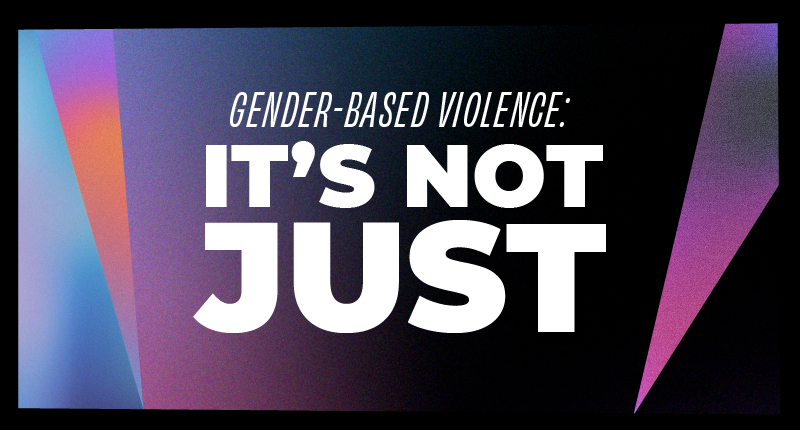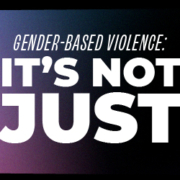3 things every coach/volunteer should know about gender-based violence (…and how to talk to young athletes about it!)

When you sign up to be a coach, you may think you are just going to run drills and design plays. Often, you unexpectedly become a trusted adult to the youth you coach.
Young athletes may come to you with questions related to gender-based violence…are you prepared to help?
Gender-based violence (GBV) is violence committed against someone based on their gender, gender expression, gender identity, or perceived gender. It can take many different forms like emotional, physical, financial, and sexual violence. Anyone can be subjected to GBV, but it most commonly impacts women, girls, and sexually and gender-diverse people.
With that in mind, here are three things you should know about GBV and how to talk to athletes about it.
#1 – It’s not just something that happens to adults
GBV does not only affect adults. In reality, 61% of women and girls aged 15-24 in Canada’s provinces have been subjected to unwanted sexual behaviours in public[1].
An important step to supporting youth in your life is understanding and acknowledging their lived experiences. As coaches, volunteers, or leaders in sports organizations, you have a unique role in shaping how youth learn about respect, boundaries, and consent.
Conversation starter 1:
A good place to start is by talking about personal boundaries. Learning to set boundaries is one of the most important ways to build self-respect and healthy relationships.
Question: Everyone has different comfort zones. What do you think personal boundaries are?
Suggested answer: Personal boundaries are limits that keep you safe, comfortable, and respected in relationships both in and out of the sport context.
In sports environments, boundaries can take many forms:
- Physical boundaries might include respecting personal space, understanding appropriate physical contact during training, or knowing when a player needs a break.
- Emotional boundaries could involve what topics they’re comfortable discussing with teammates or how they want to be treated by coaches.
- Time boundaries might relate to balancing sports commitments with other important parts of life, like school or family.
#2 – It’s not just that youth don’t want to talk about it
Sometimes, it all starts with a casual comment from your young athlete.
They might throw something out about a recent experience related to GBV to see how you will react, potentially opening the door for a deeper conversation.
If this happens, ask some open-ended questions to dig a little deeper into the issue.
Conversation starter 2
Instead of focusing only on what others expect of them, youth should know they have rights in relationships — including their relationships with teammates, coaches, and other adults in sports organizations.
Question: As an athlete, it’s important to know your rights. What rights do you think you have in the relationships in your life, including in sports.
Suggested answer: You have the right to set healthy boundaries with the people in your life. This includes:
- The right to say no.
- The right to change your mind.
- The right to ask for what you need.
#3 – It’s not just that simple
Consent is key but not widely understood. In fact, only 45% of Canadians understand what consent means[2]. Talking about consent might feel awkward, but it doesn’t have to be complicated. Here’s what youth need to know about consent.
Conversation starter 3
When it comes to any activity, agreement to engage is called consent. When young people are unaware of their rights or think they have to do things that are expected of them, they are unable to give consent.
Question: Consent is a right that all people have when interacting with others. Do you know the true meaning of consent and what it looks like?
Suggested answer: For consent to be meaningful, it must be:
- Given freely and enthusiastically: if someone is pressured or coerced into doing something, that is not consent. “No” always means “no” and needs to be respected.
- Ongoing: people can change their minds at any time during a sexual encounter — and if they do, it’s time to stop. Ongoing consent means ongoing communication. If you’re unsure how your partner is feeling, stop what you’re doing and ask.
- Specific and needed for every activity: just because someone consents to one sexual activity doesn’t mean they’re consenting to another. Ask for every activity.
- Informed: there is no such thing as consent without all the information. Consent must be given honestly without lies, manipulation or tricks between the individuals.
It’s not just how things are
You hold the power to affect meaningful change in the lives of youth.
Navigating different kinds of relationships as a young person can be difficult. They often don’t know what they don’t know, so rely on trusted adults, like you, to help them understand the world around them.
One of the best ways that you can help is by making them aware of their rights, including the importance of personal boundaries, knowing their rights, and understanding the meaning of consent.
For more resources about gender-based violence and workbooks for young people, visit: https://www.canada.ca/en/women-gender-equality/campaigns/gender-based-violence-its-not-just/gender-based-violence-resources/learning-modules-youth.html.
This article has been written in collaboration with Women and Gender Equality Canada.
[1] Gender-based violence and unwanted sexual behaviour in Canada, 2018: Initial findings from the Survey of Safety in Public and Private Spaces
[2] New Study: Less than Half of People in Canada Know What Sexual Consent Means – Canadian Women’s Foundation

